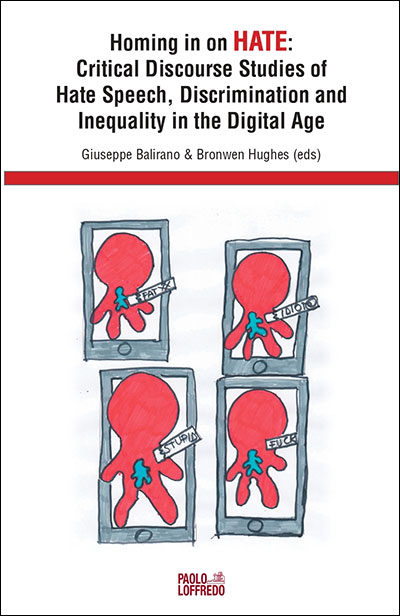Homing in on Hate: Critical Discourse Studies of Hate Speech, Discrimination and Inequality in the Digital Age
Lingua: Inglese
Editore: Paolo Loffredo Editore Srl

Descrizione
Homing in on Hate: Critical Discourse Studies of Hate Speech, Discrimination and Inequality in the Digital Age
A shared definition of ‘hate speech online’ is in a constant flux due to the supranational character of the internet, the slippery nature of online harassment, and the porous relationship between actual violence and discriminatory speech. Besides the hateful messages propagated across social networking platforms and micro-blogging sites, the recent rise of live-streamed hate has also captured public attention forcing governments and internet providers to contend with the issue of how to prevent and punish such online activities.
As the contributors highlight throughout this volume, the term ‘hate’ itself is extremely difficult to define, stemming as it does from the extremes of socio-psychopathic impulses, an inability to regulate emotions adequately, or merely from a lack of empathy. In some cases, the denigrators do not even hate their victims, they are merely pliable individuals who feel the need to emulate the sentiments of a strong cohort of denigrators in order to gain ‘insider’ status. Such individuals, however, are no less to blame than the hate mongers themselves, since they actively contribute to an echo chamber which serves to amplify and reinforce the hatred deployed. Whether they truly detest their targets or merely emulate the apparently dominant group, the aim of haters, be they online or offline, is to relegate the victims to a generic category of ‘others’, and in hate speech the other is always the enemy. The differences between the ‘us’ belonging to the dominant grouping, and the ‘them’ banished to the out-group are magnified in hate speech: the insiders are safe, legitimate, normal and rational, the outsiders are dangerous, different, threatening, and antagonistic.
Although the focus of this volume concerns, in the main, the digital environment, the editors and contributors are all well aware that ‘hate speech online’ does not occur in a virtual vacuum, its effects are dramatically real for those individuals who are on the receiving end. Cyberbullying and hate speech impinge upon the lives of individuals from social, economic, professional and psychological backgrounds, and increase the sense of fear and vulnerability of entire communities. The ever-encroaching discourse of online hate has, to date, only been partially mapped, and available studies have mostly focused on forms of misogynous attacks in the male-dominated online tech and gamer communities or against feminist activists. Additionally, there seems to be a tendency to forget that ongoing, low-level hate speech is far more common than the dramatically violent hate crimes that capture public imagination.
Whether by investigating the ripple effect triggered by a single controversial tweet, the manipulation of gender ideologies in ethnic radio discourse, or the re-semiotization of the ‘city’ as a nurturing space for Jihadist hate narratives, this book intends to address, from a wide and comprehensive multimodal perspective, the prevailing gaps in research literature and the dire need to contend with rampant vitriolic discourses today.
Una definizione condivisa di “incitamento all'odio online “ è in un flusso costante dovuto al carattere sovranazionale di internet, alla natura scivolosa delle molestie online e al rapporto poroso tra violenza effettiva e discorso discriminatorio. Oltre ai messaggi odiosi propagandati sulle piattaforme di social network e sui siti di microblogging, la recente ascesa di odio in diretta streaming ha anche catturato l'attenzione pubblica costringendo i governi e i fornitori internet a competere con la questione di come prevenire e punire tali attività online.
Come evidenziano i contributori in tutto questo volume, il termine “odio “ in sé è estremamente difficile da definire, arginando come fa dagli estremi degli impulsi socio-psicopatici, incapacità di regolare le emozioni in modo adeguato, o semplicemente dalla mancanza di empatia. In alcuni casi, i denigratori non odiano nemmeno le loro vittime, sono solo individui affidabili che sentono il bisogno di emulare i sentimenti di una forte coorte di denigratori per ottenere lo status di “insider” Tali individui, però, non sono meno da rimproverare rispetto agli stessi montatori dell'odio, poiché contribuiscono attivamente ad un'eco camera che serve ad amplificare e rafforzare l'odio schierato. Che detestino veramente i loro obiettivi o semplicemente emulino il gruppo apparentemente dominante, lo scopo degli hater, siano essi online o offline, è quello di relegare le vittime in una generica categoria di “altri “ e nell'incitamento all'odio l'altro è sempre nemico. Le differenze tra i “ noi “ appartenenti al raggruppamento dominante, e i “ loro “ banditi all'esterno sono ingrandite nell'incitamento all'odio: gli addetti ai lavori sono sicuri, legittimi, normali e razionali, gli esterni sono pericolosi, diversi, minacciosi, e antagonista.
Sebbene il fulcro di questo volume riguardi, nel principale ambiente digitale, i redattori e i contribuenti sono tutti ben consapevoli che “incitamento all'odio online “ non si verifica in un vuoto virtuale, i suoi effetti sono drammaticamente reali per gli individui che si trovano sul sto ricevendo fine. Il cyberbullismo e l'incitamento all'odio impongono alla vita di individui provenienti da ambienti sociali, economici, professionali e psicologici, e aumentano il senso di paura e vulnerabilità di intere comunità. Il discorso di odio online sempre più violento è stato, ad oggi, solo parzialmente mappato e gli studi disponibili si sono concentrati soprattutto su forme di attacchi misogini nelle comunità tecnologiche e di giocatori online dominate dai maschi o contro attivisti femministi. Inoltre, sembra che ci sia la tendenza a dimenticare che l'incitamento all'odio di basso livello è molto più comune dei crimini drammaticamente violenti che catturano l'immaginazione pubblica.
Se indagando sull'effetto increspatura scatenata da un unico tweet controverso, la manipolazione delle ideologie gender nel discorso radiofonico etnico, o la ri-semiotizzazione della “ città “ come spazio nutritivo per narrazioni di odio jihadista, questo libro intende affrontare, da un Prospettiva multimodale ampia ed esaustiva, le lacune prevalenti nella letteratura di ricerca e la direttissima necessità di contenere oggi i discorsi livolici dilaganti.
Autori
Giuseppe Balirano, PhD in English for special purposes, is full professor SSD: L-LIN / 12 (English language and translation) at the Department of Literary, Linguistic and Comparative Studies of the University of Naples "l'Orientale"
Giuseppe Balirano, dottore di Ricerca in Inglese per scopi Speciali, è professore ordinario SSD: L-LIN/12 (Lingua inglese e traduzione) presso il Dipartimento di Studi letterari, linguistici e comparati dell’Università degli Studi di Napoli“l’Orientale”.
Bronwen Hughes is a researcher at the Parthenope University in Naples. She holds a PhD in Linguistics and Modern and Comparative Literature and her research interests lie in the fields of translation as a tool for second language acquisition, cross-cultural media studies, and forensic linguistics. Her current research interests center upon the linguistic analysis of first-hand migrant narratives collected in Italy and the UK, and on the investigation of English language CLIL and EMI teaching methodologies in Italian educational contexts.
Bronwen Hughes è ricercatrice presso l’Università di Napoli Parthenope. Ha un dottorato in Linguistica e Letterature Moderne Comparate e la sua ricerca si concentra principalmente sulla traduzione come mezzo per acquisire una seconda lingua, sui media interculturali e sulla linguistica forense. Al momento i suoi interessi riguardano l’analisi linguistica delle narrazioni dei migranti, raccolte in Italia e nel Regno Unito, e sullo studio delle tecniche di insegnamento CLIL ed EMI nella lingua inglese, ma nel contesto educativo italiano.




